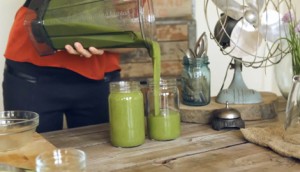Juicing has recently made a fast comeback due to the 2010 uplifting health documentary, “Fat, Sick, and Nearly Dead,” in which an autoimmune disease stricken Joe Cross reclaims his health through 60 straight days of nothing but fresh vegetable and fruit juice. Since this film, sales of juicers have soared like we are reliving the 1950’s Jack Lalane juicing craze. Aspiring health foodies today are now asking whether juicing or green smoothies have the greatest bang per buck, as high performance blenders have become the most desirable high-price kitchen appliance in American kitchens today. Here is my personal take on why green smoothies are superior to juicing.
LESS TIME:
There is nothing easier than tossing ingredients into a blender, and with a quick rinse of the container, having everything cleaned! The setup and cleanup of smoothies require little to no time whereas juicers involve a larger mess and involve more breakable parts which need to be thoroughly scrubbed and dried to prevent rusting.
HEALTHY FIBER:
The hallmark benefit of smoothies is their wonderful fiber content. The importance and deficit of fiber in the American diet cannot be overstated. As with most USRDA standards, the suggested 20-30 grams of daily fiber is a politically driven, lowest-common-denominator standard providing only enough fiber to minimize disease risk rather than promote abundant life. Considering the majority of Americans eat a measly 10-15 grams of fiber daily, the single habit of drinking a daily green smoothie alone can double the fiber intake of most diets. From my studies, a high fiber diet is one of the best ways to prevent colon cancer, an unnecessary leading cause of a cancer in the US. Stay tuned next week as I am dedicating an entire article to the healing and detoxing powers of fiber and how we can best meet America’s fiber deficit. In the rare case that an individual has a medical condition or a highly irritable digestive system, relief may be found in first juicing so as to reduce stress over whether the high fiber will irritate their stomach. Later as their health improves, switching to drinking green smoothies would be a sensible decision.
WHOLE FOODS DRINK:
Eating foods in their most whole state, whole foods, is one of the surest ways to gain the full benefits of food in all its marvelous functions. When juice is extracted from a fruit or vegetable, it becomes a fractured food—a food missing an essential component—such as fiber. Drinking a glass of orange juice over eating an orange is like eating the steering wheel of a car rather than the whole vehicle with all its remarkable functions for health and healing. Blending green smoothies in a high-performance blender such as the Vitamix and Blendtec leverages all the health benefits of whole plant foods while leaving minimal digestion and maximum nutrient extraction, as the cell walls of fruits and vegetables are literally cut into. This is called “bioavailability,” meaning that the body is able to efficiently utilize all nutrients received.
ALL-IN-ONE EASE OF USE:
My favorite aspect of drinking green smoothies over juicing is the freedom to toss in any nutritious ingredients you wish so that any recipe can become an all-in-one super drink! The options are truly endless. In a single smoothie you can add a spoon of blackstrap molasses for iron, your daily omega-3’s through chia/flaxseed, nutritional yeast for B vitamins, protein powder for satiety, yogurt, kefir, or probiotic powder to boost gut immunity, an avocado, coconut oil, or a handful of almonds for heart healthy fats, 2 Tbsp. of sesame seeds for its rich calcium, the list goes on.
VERSATILITY:
A juicer makes juice. Period. The Vitamix can make juice—and smoothies, soups, sauces, dressings, salsas, grind grains, the list goes on. If you have not already sold it at last year’s garage sale, the majority of juicers in American households are collecting dust because a subconscious thought says, “I just might pull that juicer out again someday.” Juicing enthusiasts can still enjoy traditional carrot and vegetable juice simply by straining the liquid through a nut milk bag or by drinking whole food juices by maintaining the pulp. For the most budget friendly, versatile appliance, opt for a high performance blender which performs multiple tasks for a wide assortment of recipes rather than a juicer with a low account of long-term usage.
CONCLUSIONS:
To put it simply, juicing is healthy and blending green smoothies is very healthy. Juicing has obvious health benefits which do not need to be completely disregarded but smoothies are ultimately superior for their little prep and clean up time, their much needed colon cleansing fiber, for being a whole foods drink, the freedom to blend any ingredient into an all-in-one super smoothie, and the versatility of a single high-performance blender performing the functions of many appliances. Do go ahead and watch “Fat, Sick, and Nearly Dead”—it’s a wonderful film which I highly enjoyed! But then apply the principles you learn about micro-nutrients and preventative nutrition towards powering up with green smoothies!
*Check out Leanne’s full article on green smoothies and her “The Perfect Green Smoothie” recipe HERE!









